James Raffan, canoeist-adventurer-geographer-storyteller-rambler
Hear the latest podcast with this Kickass CanadianRecorded: August 22, 2014
“I think there is wisdom in the North that could be brought to bear on the problems of the South.”
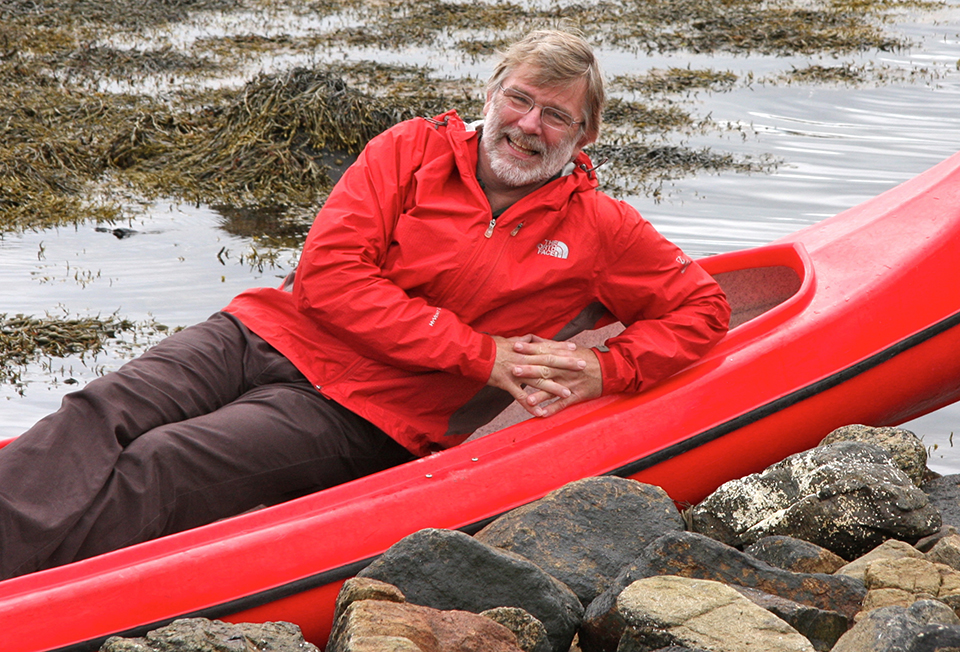
The first time James Raffan set about exploring how Arctic creatures see the world, he was in a cage with a 350kg polar bear, trying to teach the animal to press paddles to a light stimulus so he could test its “spectral sensitivity.”
It was 1976, and James, in the midst of completing a biology degree at Queen’s University, was spending the summer working in Guelph University’s seal and polar bear labs. He had his sights set on becoming a marine biologist, a hankering brought about by a childhood spent canoeing along the Speed River, reading Boy’s Own Annual adventure stories and nurturing the idea that marine biology was “this kind of intoxicating blend of exoticism, adventure and learning at the edges of the world.”
So he found himself in his hometown of Guelph, Ontario, overseeing an experiment on polar bear vision, with thoughts of pursing a Masters in marine biology after graduating from Queen’s. But things took a different turn.
As part of his work, he had to test his subject’s blood every month. That meant shooting the bear, affectionately named Huxley, at point-blank range with a tranquilizer rifle before entering the cage. After four months, James—and the bear—had had enough.
“Huxley and I came to an understanding, and the understanding was that I would bugger off,” he says. “That was a pretty significant turning point for me. That was really the end of my career as a marine biologist.”
James made a conscious decision to turn away from “that type of science” and to instead “investigate the world and engage its mysteries more holistically.” He finished up his undergrad degree in 1977, and committed to pursuing his quest for exploration outside the lab.
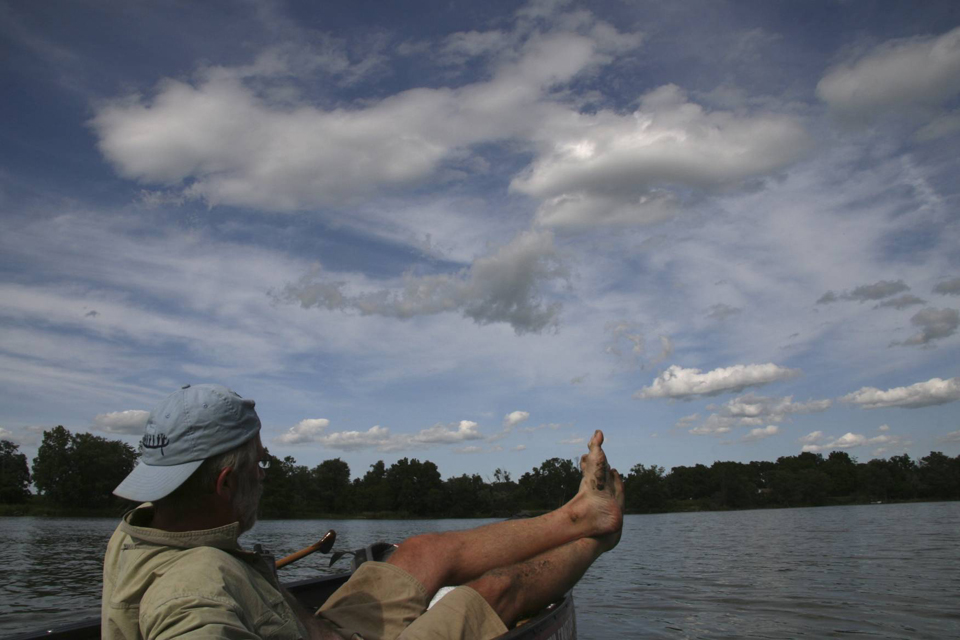
On the Grand River near Dunnville, Ont., working on a story for ‘Canadian Geographic’
In the spirit of adventure
The quest began with a construction job for Esso that took James to the North and finally enabled him to canoe in the Arctic—his dream destination. “Paddling at the ends of the earth,” he says. “The ultimate adventure.”
Since that first trip north in 1977, James has turned adventure into a lifestyle. He crosses the Arctic Circle at least once every year, and spends much of his time exploring the Arctic way of life and how its inhabitants see the world. All without using a tranquilizer gun.
James is known worldwide as a writer, speaker and explorer of the north—with a mean handle on the canoe. His 15 books include Fire in the Bones, Wildwaters, Summer North of Sixty, Deep Waters, Tumblehome, Bark, Skin & Cedar and Emperor of the North. He’s also been published in Canadian Geographic, National Geographic, Up Here, Explore and The Globe and Mail.
He speaks internationally on behalf of the Royal Canadian Geographical Society, and was recently made the group’s Explorer in Residence. His work with the Society, which includes six years as its Governor, earned him the Queen’s Jubilee Medal in 2000 and the Camsell Medal in 2009 (among his many career distinctions). James is also past Chair of the Arctic Institute of North America, a Fellow International of The Explorer’s Club and Executive Director of the Canadian Canoe Museum.
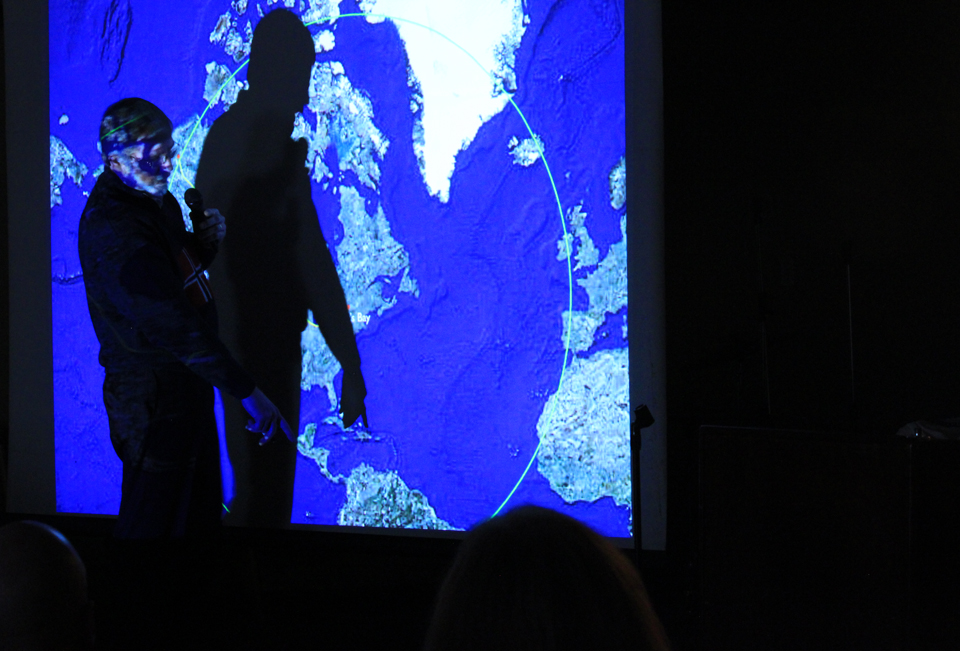
Speaking about his many adventures
By the books
For James, the route to becoming one of the world’s foremost authorities on the Arctic followed a current all its own. He started out teaching, largely as a way to fund his “rambling habit.” He completed a Bachelor of Education at Queen’s in 1978, and taught at North Dundas District High School near Ottawa, Ontario and Mackenzie High School in Deep River, Ontario, before landing a teaching position with the Queen’s Faculty of Education.
He furthered his formal education with a Master of Education from Queen’s in 1983, focusing on cultural anthropology of outdoor teaching. Finally, after taking time to marry Gail Simmons and father two daughters, Molly and Laurel, he completed a Doctor of Philosophy in 1992, also from Queen’s and with a focus on cultural geography.
All the while, James took every opportunity to explore Canada and the Arctic, usually in his canoe, but sometimes on foot, ski, bicycle and snowshoe. He worked as a researcher for Parks Canada and other northern organizations, and as an instructor and guide for the Ontario Recreational Canoeing and Kayaking Association (ORCKA) and Black Feather Wilderness Adventures.
Now, having stepped away from his position as Coordinator of Queen’s University’s Outdoor and Experiential Education (OEE) program, he remains happily settled on Cranberry Lake in Seeley’s Bay, Ontario. Working from home, he continues to pass on—and build on—his impressive knowledge of life in the North. Whether in person, in writing or over the radio, he is devoted to sharing stories of the people and places he’s seen. It’s a calling he attributes to his journaling days, when, as a youngster, he was so entranced by the worlds he discovered from his canoe that he felt compelled to pick up a pen and write.
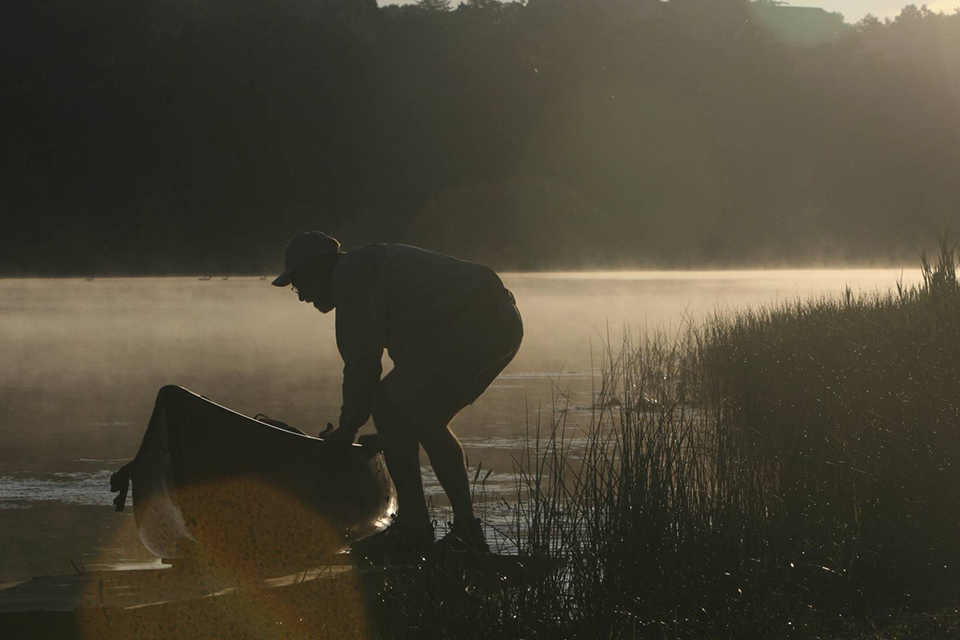
On the Grand River, near Paris, Ont.
By the river
Young James first wet his paddle on canoeing trips with the Guelph Recreation Commission and Scouts Canada. From the beginning, he saw the intrepid boat as “a vessel of exploration.”
His love of canoeing came about “with the consciousness of a five-year-old looking out at the Speed River and realizing it came from somewhere, it went to somewhere,” he says. “I don’t know exactly the progression, but I do know that I read the book Paddle to the Sea, and saw Bill Mason’s National Film Board adaptation when it came out, and that, combined with my imaginings living on a river in southwestern Ontario, (made me think) I could go anywhere. I could go to Toronto or Vancouver or the North Pole; it didn’t seem to matter. I had this sense that the river was a place of access.”
As a first-generation Canadian whose parents emigrated from England, says James, “I’ve spent my life so far exploring this country that I accidentally ended up in.” (His parents flipped a coin to determine whether they’d move to Canada or South Africa.) He says he feels obliged to honour the good fortune of living “in a country that’s peaceful and beautiful and populated by very tolerant—maybe too tolerant—indigenous people.” For him, that means “telling the stories of the amazing things that happen when we start travelling the waterways of the country, on snowshoes in the winter and by canoe in the summer.”
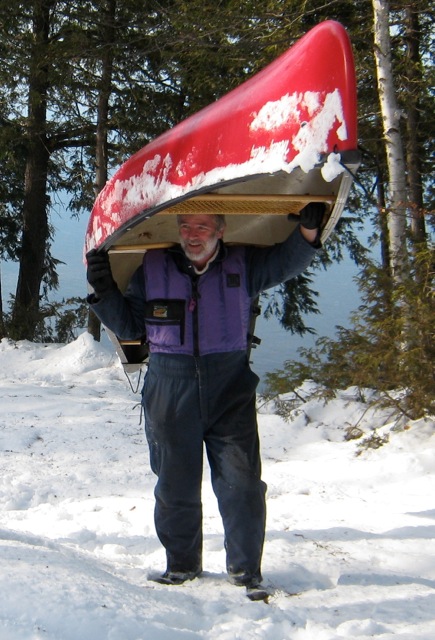
Canadian Canoe Museum
The canoe, of course, plays a big part in the story of Canada’s waterways. So it stands to reason that James is deeply involved with an organization devoted to preserving and promoting the history of the canoe.
The Canadian Canoe Museum in Peterborough, Ontario was founded in 1997, featuring a collection of canoes, kayaks and self-propelled craft gathered by Kirk Wipper. Kirk was the former owner of renowned Camp Kandalore and a long-time mentor of James’, who eagerly volunteered at the museum as part of the exhibit design team before becoming curator in 2007.
Today, working from his home office, James is the museum’s part-time Executive Director, a position he sees as a privilege and an honour. “The museum holds a precious essence of Canada,” he says. “Canada is a nation of rivers. And, as such, it’s a nation of canoes. There’s something essential and elemental about our country’s cultural diversity and ingenuity wrapped up in the museum’s collection of 600+ canoes.
“The canoe is the vessel with which First Nation, Métis and Inuit people have primary experience, but it’s also a vessel with which the other two founding peoples of this country—the French and the English—have some sort of common experience. No matter where you go in this country, there are canoes. Canoes carry with them lessons about where we came from and how we got to where we are, but also lessons about how to live our lives now and how to pull together into the future.”
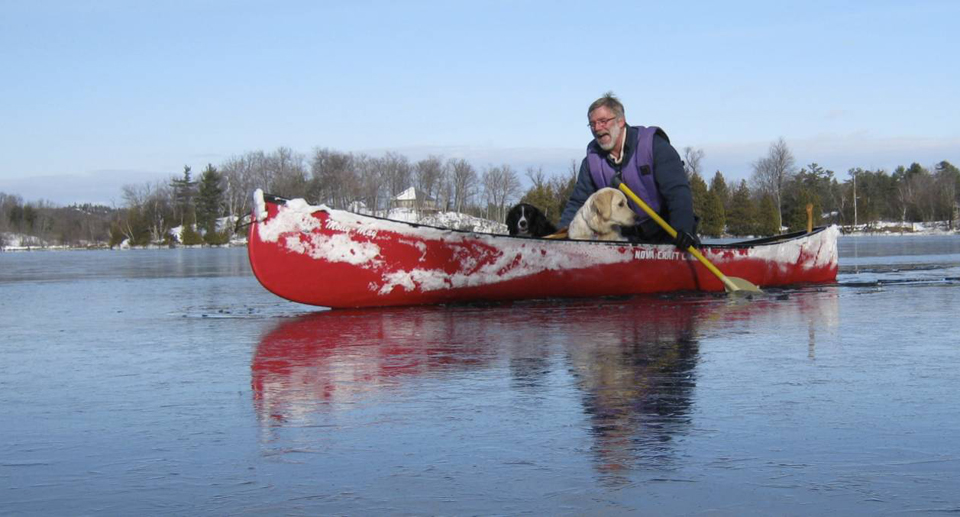
On Cranberry Lake, Seeley’s Bay, Ont., with his Border Collie, Fiona, and Golden Retriever, Animosh
Thames Diamond Jubilee Pageant
That reverence for the canoe and its importance to our heritage was recently reflected back to James a hundredfold. He just came home from London, England, where he organized the Canadian entry in the Thames Diamond Jubilee Pageant in honour of Her Majesty the Queen’s 60th year on the throne. Since his return, he’s received hundreds of emails, texts and messages, and about a third of them, he says, came from people confessing that they “got weepy” when they saw the Canadian Canoe Museum’s boat—the Canada One/Un, the only “truly Canadian canoe” in the event—cruising along the Thames amongst all the other craft.
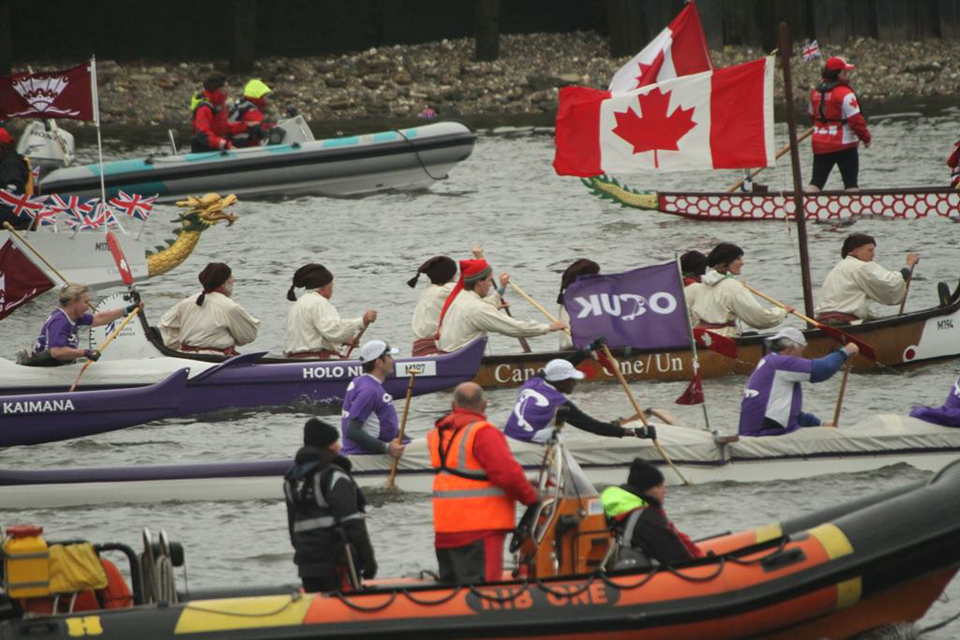
The Canada One/Un at the Thames Diamond Jubilee Pageant, London, England, 2012
“That was really heartening for me,” he says. “(At the museum), we’ve been trying to take the bushel basket off the light that is this amazing collection (of canoes). To be seen by thousands of people on the banks of the Thames and billions of people on television is exactly what the museum needs. And this overwhelmingly positive response to the Jubilee flotilla tells me that there is an appreciation for the history of the canoe, and an audience for the story we’re trying to tell through travelling exhibits and our website. It’s a defining Canadian story.”
You can read about his adventures with the Canada One/Un on the Canadian Canoe Museum’s blog. He’ll also recount his Thames canoe caper this September at the Seeley’s Bay and Area Residents Association’s AGM, and likely again at the museum’s annual volunteers’ potluck dinner later this year. “It’s a story that everyone involved with the project will be telling for the rest of their lives,” he says.
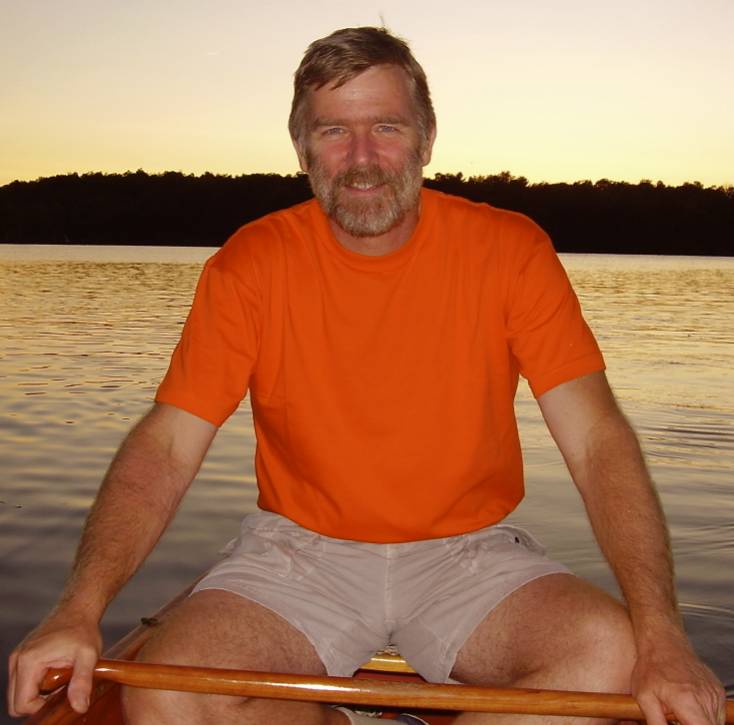
On Cranberry Lake, Seeley’s Bay, Ont.
Circling the Midnight Sun
Another story deemed worthy of sharing by this master storyteller is the one that takes place up North. James is currently tackling his biggest writing project yet in an effort to “explore the future of the Arctic through the experience of Canada’s neighbours throughout the circumpolar world.”
Circling the Midnight Sun is a chronicle of his recently completed journey around the Arctic, which spanned nearly two years and took him through Canada, Greenland, Iceland, Scandinavia, Russia and Alaska. It’s currently available as an ongoing 24-part blog published on the Canadian Geographic website. In 2014, Circling the Midnight Sun will also be released as a book published by HarperCollins Canada.
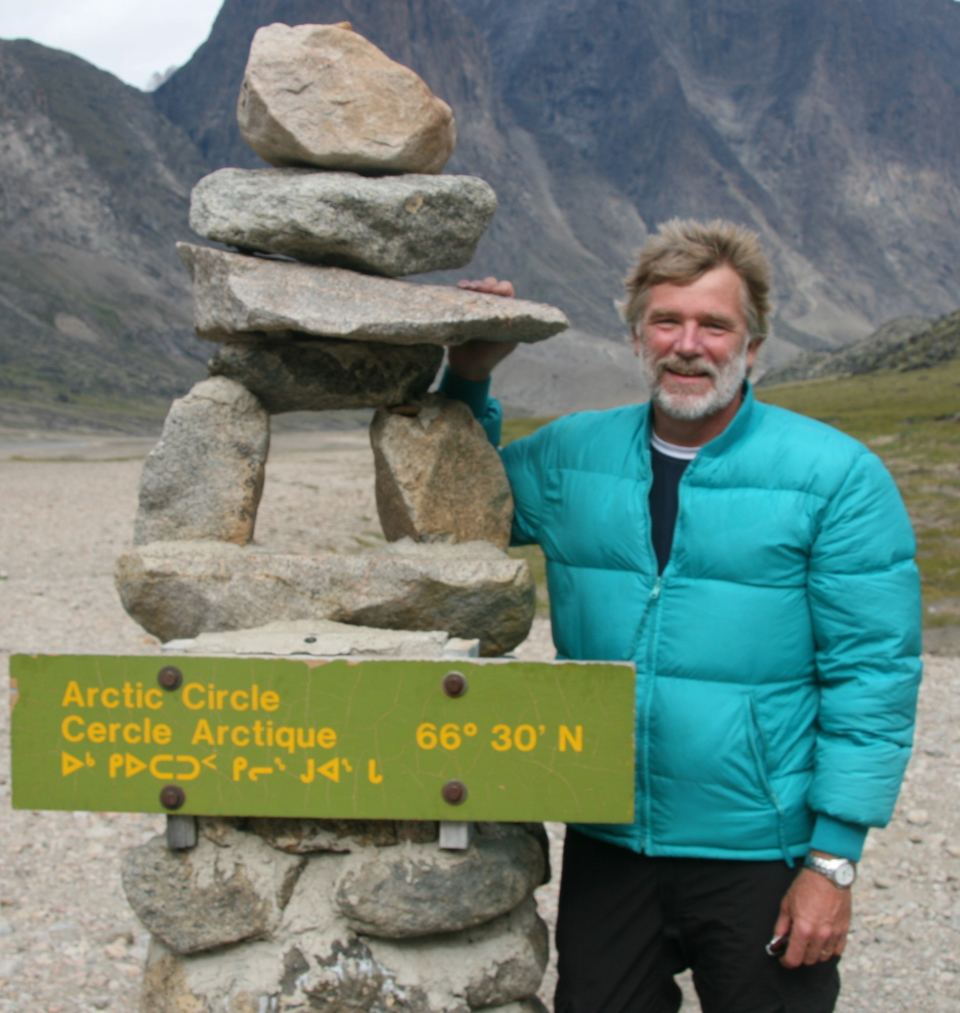
At the Arctic Circle monument in Akshayuk Pass, Auyuittuq National Park, Baffin Island, NU
James initiated the project as a way to shed new light on the North, so he could share the rich cultures and traditions of the people living there. “Many, many people are turning to the Arctic now because of climate change,” he says. “They watch TV and read about it in the paper, and for many of them, the image that comes back is that of the polar bear.
“Having spent considerable time in the North over the last 35 years, and having worked with Huxley, I know that the problems of the polar bear are not trivial… But I think the world needs to know that there are four million two-legged animals who live above the Arctic Circle, all of whom have been reacting and responding to change for millennia. Climate change is just the next in a long series of life-changing circumstances with which northerners have had to cope. In the same way that biologists went into the tropical rain forest to find new cures for the epidemiological scourges of the middle earth, I want to uncover (cures that lie) in the Arctic. I think there is wisdom in the North that could be brought to bear on the problems of the South.”
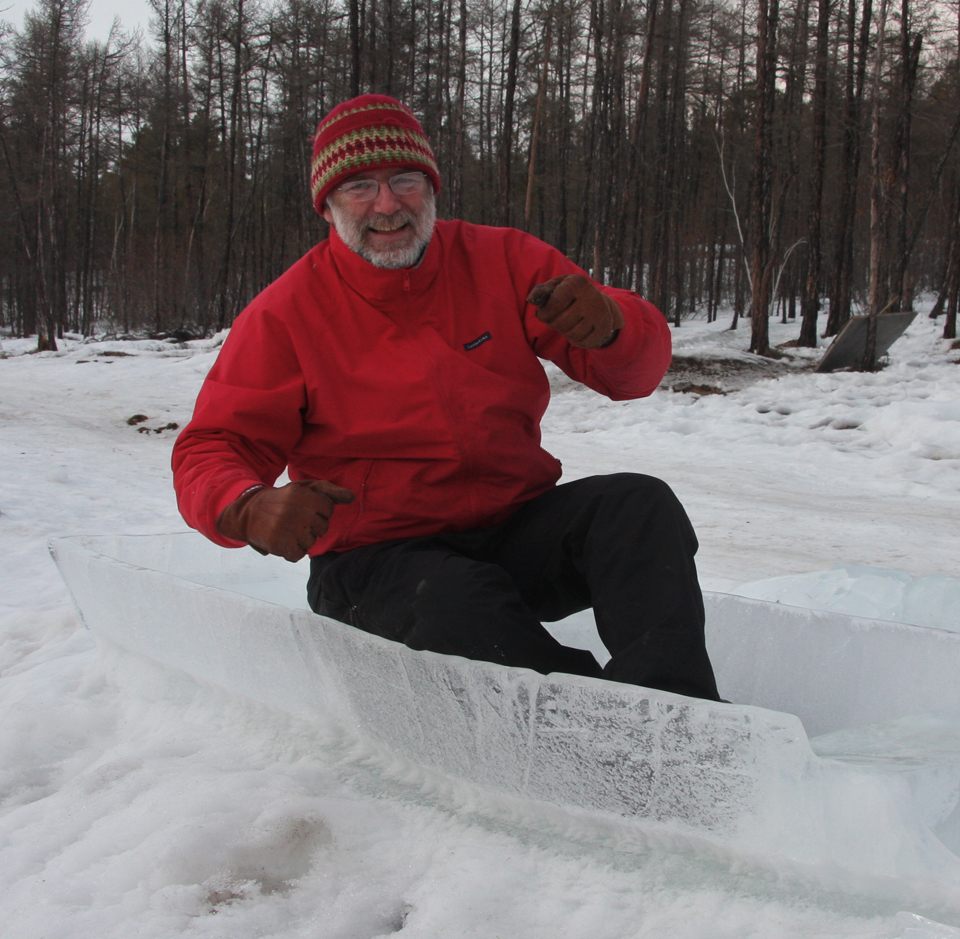
Paddling an ice canoe in Central Siberia, 2011
Through northern eyes
So today, three dozen years after trying to understand what Huxley the polar bear could see, James continues to look for ways to explore and reveal what animals native to the Arctic truly perceive. He’s stepped away from the cage and into a world he believes can offer profound and essential insights.
“I first went to the North to see the natural world,” he says. “Like so many Canadians, I’d been weaned on a diet of Group of Seven paintings, which don’t show any people in them, and stories of conquest that rarely acknowledged the presence of northern residents in the places that were explored. But the more I went to the North, the more I got involved with northerners. I see now that you can’t really understand the North until you have a good sense of the people who live there.
“I might have gone first to behold and to walk with charismatic large mammals, and catch fish that I could eat raw with wasabi on the side of the river. But I came to see this place that I once imagined as unpeopled, as a profoundly human context with tremendous amounts to teach people in more southern locales.”
* * *
For the latest on James, visit jamesraffan.ca, follow him on LinkedIn and @raffjam on Twitter, or email [email protected].
Thank you to Ottawa, Ontario’s Jay Ankersmit and Kickass Canadian Shelagh Rogers, Ambassador at Large for the Canadian Canoe Museum, for recommending James as a truly Kickass Canadian.
 Kickass Canadians
Kickass Canadians
Wow you do kick ass! I do not know if you remember me from the early Trailhead days…but I remember you. My heart is only and always at peace under a pine tree, beside a lake and near my canoe. How great is it to live in this great country called Canada!
Thanks for the wonderful comment, Martha!
A few years ago I had the pleasure of being a member of the group performing songs from the Canoe Songs Volume II project – of which James was the executive producer – at the amazing Canadian Canoe Museum.
I am proud to call James my friend and canoeing mentor as well.
Thanks for this great article.
Jerry, thank YOU for sharing your thoughts. Really glad you enjoyed the article.
You live a very interesting life! I am an outdoors man and I think I’m happiest when I’m in the forest or in my canoe! Lol I have also hitch hiked across Canada three times. I love adventure!
This was a great article! I write articles on my trips and adventures but I am not the greatest writer, so I have yet to get a story published. It is still cool to know that someone like you started just outside my hometown. Thanks for the story!
Thanks for the comment, Mike! Glad you enjoyed the article – good luck with your own writing. 🙂
Hitching across Canada… that notion just makes me homesick for the open road and a time when that was considered acceptable as self-directed character education. So different and sovereignly more rewarding than the ‘thumbing’ that’s happening on hand-held devices on the highways and biways of the world wide web!
“He was standin’ by the highway with a sign that just said, Mother …”
Your note has sent me an a very happy trip down memory lane, Mike. Thanks!
Speaking of remembering – I remember you, Martha MacKenzie, from Strathcona Park Lodge – 1981. You and Joe, me and Raphael – I think you had just started Trailhead? I came back to Campbell River 11 years ago, Raphael passed away seven years ago. I helped Myrna write the history of the Lodge. Lots of Kickass Canadians there! Please look me up – I’m on Facebook under Catherine Marie Gilbert or my website: catherinegilbert.ca.
I am at this time reading your book “Rendezvous with the Wild – The Boreal Forest.” What has happened to this area in the last 10 years? Where can I look this information up? It brings tears to my eyes to think that most of this beauty may be gone. Thank you for the knowledge and images and a great book. I may be 10 years late reading it, but things come into your life at the proper time.
Bernadette, thanks for your comment. James’ email is listed above – try contacting him there wrt his book. All the best!
Pleased to hear, Bernadette, that Rendezvous with Wild is still out there. Keeping a goodly portion of the boreal forest wild remains a work in progress but some important things have happened since the book was published. Not least is the signing of the Canadian Boreal Forest Agreement which commits the 24 members of the Forest Products Association of Canada to work collaboratively with the Canadian Parks and Wilderness Society and other environmental groups to achieve a bunch of important conservation goals. CPAWS, who initiated the Rendezvous with the Wild project, has a long and distinguished track record working with the forest industry to improve conservation within Canada’s forests. You can connect with all the on-going activity at cpaws.org
Hello Jim, Carol and I are attending the gala on Oct. 19 and hope to see you there. As you may know, I am on a new artist bent that involves interpretations of wilderness using pen and ink on birch bark. The work has been well received. I am donating a piece for the gala auction. I would like to contribute further in some way to raising funds by selling the work in some way through the museum you would deem appropriate. I would enjoy exploring this with you and the staff. I have many pieces on hand at present and my fiend Norm Cowan has more raw bark for me to sketch on this fall. Look forward to hearing from you , Ralph Ingleton
Woah, Ralph: You’ve moved from three dimensions to two … or maybe that’s not fair … from stone sculpture to birch bark. You’re such a fine artist, I’m sure birch bark art will never be the same. So pleased you’re attending the Canadian Canoe Museum gala, continuing your long standing interest and support. Look forward to seeing the new work and to talking about future collaborations. JR
Hi James, my kids gave me a birthday gift in 2012 – a VIA Rail trip across Canada from Vancouver to Oakville. And my Oakville son’s friend gave us a weekend on Lower Buckhorn Lake. So we visited your Museum – alas, at the very time you were boarding the plane with the Queen’s Canoe! However, we were thrilled to see you in the Thames Flotilla, and to hear you received an award there.
Last Christmas in Oakville, I was in touch with two Banff Springs Hotel roommates, Janet (Barnes) Douglas and Mary (Wingate) Mercer, who have been Canoe Club enthusiasts for many years. They admitted they hadn’t ever been in your wonderful museum! I couldn’t believe it! I described how excellent it is and they promised to visit it.
Today, with the exciting news of the Franklin Expedition ship discovery, I revisited your book “Emperor of the North.” It is so ironic that such a poorly planned for expedition has spawned such a lucrative business ever since. AND that Simpson, who was knighted for helping them, despite his negative hunch, has been so disparaged in history (not by you), and that Harper, who is doing his best to scour out Canada (the Trilateral Commission’s Agenda?), will be claiming the glory. Heh, heh. I wonder whether you were involved with any of those exploratory ships? My son knows one of the captains. Exciting networking! Cheers, MaryLouise Stathers Simpson